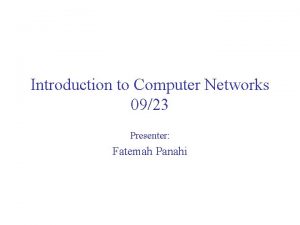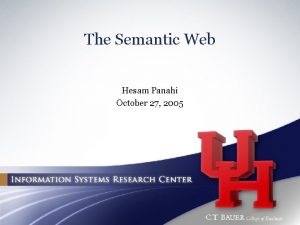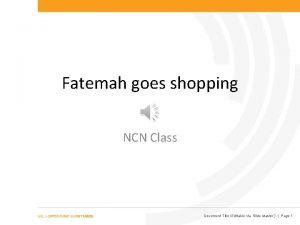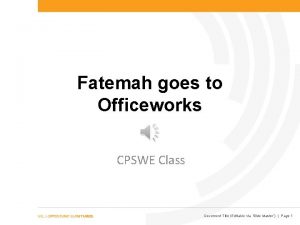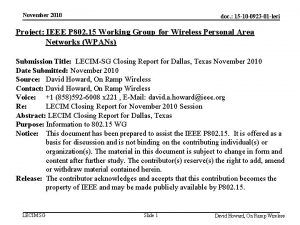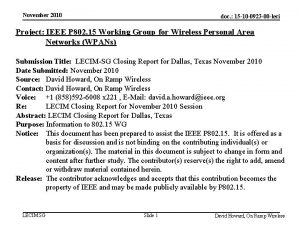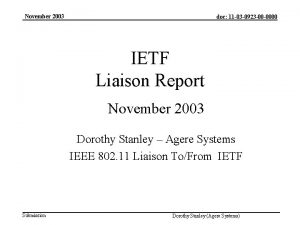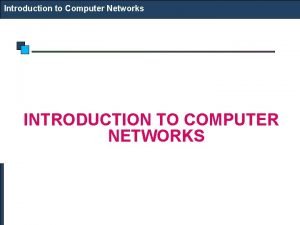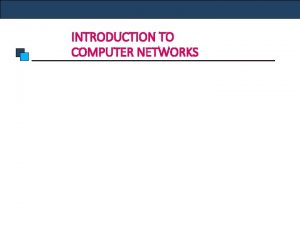Introduction to Computer Networks 0923 Presenter Fatemah Panahi














- Slides: 14

Introduction to Computer Networks 09/23 Presenter: Fatemah Panahi

Outline • • Client-Server code Project overview Review from last session Spanning Tree Algorithm

Review • Shared medium vs. Point to point links • Ethernet as a shared medium link • LAN is a Local Area Network, Usually based on the Ethernet technology • Ethernet limitation: Cable length, Host number

Extending LANs • Repeaters: A device that forwards signals, just like an amplifier • Hub: A multi-way repeater; Usually used when you cannot attach a host directly to a thin cable. • No notion of frames • Broadcast: Everybody can get the message that someone sends.

Bridges = LAN switches • Switch: multi-input, multi-output device which transfers packets from an input to one or more outputs • Using repeaters to extend a LAN has its own limits: – Total number of repeaters – Total length • Alternative: Have a node between 2 Ethernet segments to forward frames – Isolates collision domains if used carefully – Increases total bandwidth of the network

Learning Bridges • It is inefficient to always broadcast message to all Ethernet segments • How do we know on which port a host is? – Manual table – Learning mechanism • Learning: – Inspect the source address of each frame – Each table entry has a timeout – Not sure what to do? Broadcast

Spanning Tree How to handle forwarding in complex Layer 2 topologies? CS 640 7

Each LAN segment can have many bridges • More complex topologies can provide redundancy. – But can also create loops. • E. g. What happens when there is no table entry? – Multiple copies of data Could crash the network has happened often! host host Bridge host

What is a Spanning Tree? • Reduce our topology graph to a tree: – Make sure there are no loops in the topology – All LAN segments are still connected to the LAN and can receive messages • Main idea: Bridges choose the ports over which they have to forward frames.

Spanning Tree Protocol Overview Embed a tree that provides a single unique default path to each destination: Bridges designate ports over which they will or will not forward frames By removing ports, extended LAN is reduced to a tree Addresses the crashing problem; but tree is not resilient When switch/link fails, rerun protocol to converge to new tree

Spanning Tree Algorithm • Root of the spanning tree is elected first the bridge with the lowest identifier. – All ports are part of tree • Each bridge finds shortest path to the root. 2 B 3 B 5 1 1 B 7 1 B 2 – Remembers port that is on the shortest path – Used to forward packets • B 1 Select for each LAN a designated bridge that will forward frames to root – Has the shortest path to the root. – Identifier as tie-breaker B 6 1 1 B 4

Spanning Tree Algorithm • Each node sends configuration message to all neighbors. – Identifier of the sender – Id of the presumed root – Distance to the presumed root • 2 B 3 Initially each bridge thinks it is the root. B 5 1 – B 5 sends (B 5, 0) • When B receive a message, it decide whether the solution is better than their local solution. 1 B 7 1 B 2 – A root with a lower identifier? – Same root but lower distance? – Same root, distance but sender has lower identifier? • Message from bridge with smaller root ID – Not root; stop generating config messages, but can forward • B 1 Message from bridge closer to root – Not designated bridge; stop sending any config messages on the port B 6 1 1 B 4

Spanning Tree Algorithm • Each bridge B can now select which of its ports make up the spanning tree: – B’s root port – All ports for which B is the designated bridge on the LAN • States for ports on bridges 2 B 3 B 5 1 1 B 7 1 B 2 – Forward state or blocked state, depending on whether the port is part of the spanning tree • Root periodically sends configuration messages and bridges forward them over LANs they are responsible for • Any bridge failure => Start over B 1 B 6 1 1 B 4

Spanning Tree Algorithm Example –B 3 receives (B 2, 0) –Since 2<3 B 3 accepts B 2 as a root –B 3 adds one to the distance advertised by B 2(0) and thus sends (B 3, B 2, 1) toward B 5 –Meanwhile B 2 accepts B 1 as the root and sends (B 2, B 1, 1) –B 5 accepts B 1 as the root and sends (B 5, B 1, 1) –B 3 accepts B 1 as the root and figures that B 1 and B 2 are closer to the root. So stops forwarding on both interfaces. 2 B 3 B 5 1 1 B 7 1 B 2 B 1 B 6 1 1 B 4
 Node bridge
Node bridge Virtual circuit switching example
Virtual circuit switching example Basestore iptv
Basestore iptv Crc in computer networks
Crc in computer networks Crc in computer networks
Crc in computer networks Traffic management in computer networks
Traffic management in computer networks Tpdu in computer networks
Tpdu in computer networks What is optimality principle in computer networks
What is optimality principle in computer networks Snmp osi model
Snmp osi model What is optimality principle in computer networks
What is optimality principle in computer networks Business application of computer network
Business application of computer network Classify computer networks based on transmission technology
Classify computer networks based on transmission technology Intro dns
Intro dns Intserv vs diffserv
Intserv vs diffserv Icmp in computer networks
Icmp in computer networks
